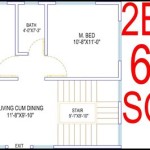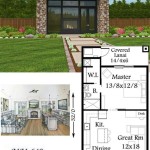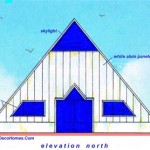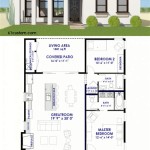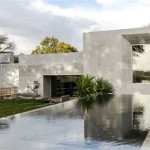Single-storied house plans are architectural designs for dwellings with all living spaces situated on a single level. They provide a practical and often preferred option for individuals seeking convenience, accessibility, and efficient use of space.
These plans are particularly suitable for elderly individuals, families with young children, or those with mobility limitations. By eliminating the need for stairs or multiple levels, single-storied houses ensure ease of movement and accessibility throughout the home.
In this article, we will explore the various aspects of single-storied house plans, including their advantages, design considerations, and popular layouts. We will also provide tips and resources to assist you in choosing and implementing the perfect single-storied home plan for your needs.
Here are 10 important points about single-storied house plans:
- Convenient and accessible
- Suitable for various lifestyles
- Improved mobility and safety
- Efficient use of space
- Cost-effective to build
- Easier to maintain
- Versatile design options
- Energy-efficient
- Ideal for aging in place
- Meets ADA accessibility standards
Single-storied house plans offer numerous advantages, making them a popular choice for individuals seeking comfort, convenience, and practicality in their homes.
Convenient and accessible
Single-storied house plans are incredibly convenient and accessible, offering a range of benefits that enhance the quality of life for residents. Firstly, the elimination of stairs and multiple levels removes potential barriers to movement, making it easier for individuals of all ages and abilities to navigate the home safely and independently.
This accessibility is particularly advantageous for elderly individuals or those with mobility limitations. By providing a single level of living space, single-storied homes allow residents to maintain their independence and quality of life, as they can easily access all areas of the home without the need for assistance or specialized equipment.
Furthermore, single-storied house plans promote convenience in everyday tasks. With everything located on one level, residents can easily move between rooms and access common areas without having to navigate stairs or hallways. This streamlined layout reduces time spent on daily tasks and errands, providing greater efficiency and comfort.
In addition, single-storied homes can be designed to meet specific accessibility needs. Wider doorways, ramps, and roll-in showers can be incorporated into the plan to accommodate wheelchairs and mobility aids. These features enhance accessibility for individuals with disabilities, ensuring that they can live comfortably and independently in their own homes.
Overall, the convenience and accessibility of single-storied house plans make them an ideal choice for individuals seeking a comfortable, safe, and independent living environment.
Suitable for various lifestyles
Single-storied house plans are highly versatile and adaptable, catering to a wide range of lifestyles and preferences. One of their key advantages is the ability to accommodate diverse living arrangements and family structures.
For families with young children, single-storied homes provide a safe and convenient environment. With everything located on one level, parents can easily supervise their children and ensure their safety. The open and accessible layout allows for seamless interaction between family members, fostering a sense of togetherness and connection.
Empty nesters and retirees also find single-storied homes to be an ideal choice. As individuals age, the need for accessibility and convenience becomes more pronounced. Single-storied homes eliminate the challenges associated with stairs and multiple levels, allowing seniors to age in place with dignity and independence.
Furthermore, single-storied house plans can be customized to suit specific lifestyles and hobbies. For example, individuals with a passion for gardening can incorporate a dedicated gardening space or greenhouse into their home’s design. Those who enjoy entertaining can opt for open-concept living areas that seamlessly connect to outdoor patios or decks, creating an ideal space for hosting gatherings.
Overall, the versatility and adaptability of single-storied house plans make them a suitable option for individuals and families from all walks of life, providing a comfortable and supportive living environment that aligns with their unique lifestyles and needs.
Improved mobility and safety
Single-storied house plans offer significant advantages in terms of improved mobility and safety for residents of all ages and abilities.
- Elimination of stairs and steps: One of the primary benefits of single-storied homes is the absence of stairs and steps. This feature greatly reduces the risk of falls and accidents, particularly for elderly individuals or those with mobility impairments. By eliminating vertical barriers, single-storied homes promote safe and independent movement throughout the living space.
- Enhanced accessibility: Single-storied house plans provide enhanced accessibility for individuals using wheelchairs or other mobility aids. Wide doorways, ramps, and accessible showers can be easily incorporated into the design, allowing for seamless movement and ease of use. This accessibility not only improves the quality of life for individuals with disabilities but also ensures that the home can adapt to changing needs over time.
- Improved visibility and supervision: With everything located on one level, single-storied homes offer improved visibility and supervision. Parents can easily keep an eye on young children, and caregivers can monitor elderly residents without having to navigate multiple levels. This enhanced visibility promotes a sense of security and well-being for all occupants.
- Reduced risk of tripping hazards: Single-storied homes typically have fewer tripping hazards compared to multi-storied dwellings. By eliminating stairs and steps, as well as potential obstacles such as uneven flooring or loose rugs, the risk of falls and injuries is significantly reduced. This creates a safer environment for all residents, fostering peace of mind and well-being.
Overall, single-storied house plans prioritize mobility and safety, creating a living environment that is accessible, convenient, and supportive for individuals of all ages and abilities.
Efficient use of space
Single-storied house plans offer an efficient use of space, maximizing the functionality and livability of the home while minimizing wasted or underutilized areas.
One of the key advantages of a single-storied layout is the elimination of vertical space, such as stairs and hallways. This allows for a more efficient distribution of square footage, as the entire floor area can be dedicated to living spaces. As a result, single-storied homes tend to have a more spacious and open feel compared to multi-storied dwellings.
Furthermore, single-storied house plans promote a more fluid and cohesive flow of movement throughout the home. With everything located on one level, there is no need to navigate stairs or hallways to access different rooms. This streamlined layout reduces wasted time and effort spent on daily tasks and errands, enhancing the overall convenience and efficiency of the living space.
Additionally, single-storied homes provide greater flexibility in terms of space planning and furniture placement. The absence of vertical barriers allows for more creative and versatile use of space. For example, open-concept living areas can be easily incorporated into the design, seamlessly connecting different functional zones within the home. This flexibility empowers homeowners to customize their living space to suit their specific needs and preferences.
Overall, the efficient use of space in single-storied house plans maximizes functionality, livability, and flexibility, creating a comfortable and cohesive living environment that meets the diverse needs of modern homeowners.
Cost-effective to build
Single-storied house plans offer several advantages that make them a cost-effective option compared to multi-storied dwellings.
- Reduced foundation costs: Single-storied homes require a smaller and less complex foundation compared to multi-storied buildings. This reduction in foundation size and complexity translates into significant savings on construction costs.
- Simplified structural system: Single-storied homes typically have a simpler structural system compared to multi-storied buildings. The elimination of multiple levels and the reduced need for load-bearing walls result in lower material costs and less labor-intensive construction.
- Efficient use of materials: Single-storied house plans promote efficient use of building materials. With no vertical space to enclose, there is less need for materials such as lumber, drywall, and roofing. This reduced material consumption contributes to lower construction costs.
- Reduced labor costs: The construction of single-storied homes is generally less labor-intensive compared to multi-storied buildings. With everything located on one level, there is no need for scaffolding, specialized equipment, or additional labor to complete the construction process.
Overall, the simplified design, reduced material consumption, and lower labor costs associated with single-storied house plans make them a cost-effective option for homeowners seeking to build a new home.
Easier to maintain
Single-storied house plans offer significant advantages in terms of maintenance and upkeep, making them an ideal choice for individuals seeking a low-maintenance living environment.
One of the key benefits of single-storied homes is the ease of exterior maintenance. With everything located on one level, there is no need for ladders, scaffolding, or specialized equipment to reach and maintain the exterior surfaces of the home. This simplified maintenance process saves time, effort, and potential safety hazards associated with working at heights.
Furthermore, single-storied homes have a smaller roof area compared to multi-storied dwellings. A smaller roof area means less surface area to inspect, repair, or replace, resulting in reduced maintenance costs and effort. Additionally, single-storied homes often have more accessible rooflines, making it easier and safer to perform regular maintenance tasks such as cleaning gutters or checking for potential issues.
The absence of stairs and multiple levels in single-storied homes also simplifies interior maintenance. With everything located on one floor, there are fewer surfaces to clean, dust, or vacuum. This reduced cleaning time and effort contribute to a more manageable and time-efficient maintenance routine.
Overall, the ease of exterior and interior maintenance in single-storied house plans makes them a low-maintenance option, allowing homeowners to spend less time on upkeep and more time enjoying their living space.
Versatile design options
Single-storied house plans offer a wide range of versatile design options, allowing homeowners to customize their living space to suit their unique needs and preferences.
- Open-concept layouts: Open-concept layouts are a popular choice for single-storied homes, as they create a spacious and airy feel. By removing walls between the living room, dining room, and kitchen, open-concept layouts promote a sense of togetherness and encourage interaction among family members and guests. These layouts are particularly well-suited for entertaining and fostering a sense of community within the home.
- Flexible room configurations: Single-storied homes provide flexibility in room configurations, allowing homeowners to adapt the space to their changing needs. For example, a spare bedroom can be easily converted into a home office, a guest room, or a playroom for children. This flexibility ensures that the home can accommodate different lifestyles and family dynamics over time.
- Indoor-outdoor living: Single-storied homes often have easy access to outdoor spaces, such as patios, decks, or gardens. By incorporating large windows and sliding doors, homeowners can seamlessly connect their indoor and outdoor living areas. This integration of indoor-outdoor spaces creates a sense of spaciousness and brings the beauty of nature into the home.
- Customizable facades: The facades of single-storied homes can be customized to reflect the homeowner’s personal style and preferences. From traditional designs to contemporary styles, there are endless possibilities for creating a unique and visually appealing exterior. Homeowners can choose from a variety of materials, such as brick, stone, stucco, or siding, to create a facade that complements the overall design of the home and enhances its curb appeal.
The versatile design options available with single-storied house plans empower homeowners to create a living space that truly reflects their lifestyle, taste, and aspirations.
Energy-efficient
Single-storied house plans offer inherent advantages for energy efficiency, contributing to lower energy consumption and reduced utility bills for homeowners.
One key factor contributing to the energy efficiency of single-storied homes is their compact design. With everything located on one level, there is less exterior surface area exposed to the elements. This reduced surface area minimizes heat loss and gain, resulting in more efficient temperature control throughout the home. Additionally, single-storied homes often have a smaller roof area compared to multi-storied dwellings, which further reduces heat loss through the roof.
Another advantage of single-storied homes is the ease of incorporating passive solar design principles. By carefully positioning windows and doors to maximize natural light and heat gain, homeowners can reduce their reliance on artificial lighting and heating systems. Single-storied homes are particularly well-suited for passive solar design, as the lower roofline allows for larger windows and better access to sunlight.
Furthermore, single-storied house plans provide greater flexibility for incorporating energy-efficient technologies and features. For example, homeowners can easily install solar panels on the roof to generate renewable energy and reduce their carbon footprint. Additionally, single-storied homes are ideal for geothermal heating and cooling systems, which utilize the stable temperature of the earth to provide efficient heating and cooling throughout the year.
Overall, the compact design, ease of incorporating passive solar principles, and flexibility for integrating energy-efficient technologies make single-storied house plans an excellent choice for homeowners seeking to reduce their energy consumption and live in a more sustainable and eco-friendly environment.
Ideal for aging in place
Single-storied house plans are particularly well-suited for individuals seeking to age in place, as they provide a safe, comfortable, and accessible living environment that supports independent living and well-being.
- Elimination of stairs and steps: One of the primary advantages of single-storied homes for aging in place is the absence of stairs and steps. This feature greatly reduces the risk of falls and accidents, which are common concerns for elderly individuals. By eliminating vertical barriers, single-storied homes allow residents to move around their living space safely and independently, maintaining their mobility and quality of life.
- Enhanced accessibility: Single-storied house plans can be designed to incorporate accessible features that meet the specific needs of aging residents. Wider doorways, ramps, roll-in showers, and grab bars can be seamlessly integrated into the design, ensuring that the home is accessible and comfortable for individuals with mobility impairments or disabilities. These features promote independence and dignity, allowing seniors to live in their own homes for as long as possible.
- Adaptable living spaces: Single-storied homes provide adaptable living spaces that can be easily modified to accommodate changing needs over time. For example, doorways can be widened to accommodate wheelchairs, and bathrooms can be remodeled with accessible fixtures and features. This adaptability ensures that the home can continue to meet the needs of aging residents as their circumstances change, supporting their safety and well-being in the long term.
- Improved safety and security: Single-storied homes offer improved safety and security for elderly residents. With everything located on one level, it is easier for caregivers or family members to monitor and assist individuals who may require additional support. Additionally, single-storied homes are less susceptible to break-ins and other security concerns, as there are fewer entry points and potential hiding places for intruders.
Overall, the elimination of stairs, enhanced accessibility, adaptable living spaces, and improved safety features make single-storied house plans an ideal choice for individuals seeking to age in place with dignity, independence, and peace of mind.
Meets ADA accessibility standards
Single-storied house plans can be designed to meet the accessibility standards outlined by the Americans with Disabilities Act (ADA), ensuring that individuals with disabilities have equal access to housing and can live independently with dignity and comfort.
To comply with ADA accessibility standards, single-storied homes must incorporate specific design features that address the needs of individuals with mobility impairments, sensory impairments, and cognitive disabilities. These features include:
- Accessible entrances and exits: All entrances and exits must be accessible to individuals using wheelchairs or other mobility aids. This includes providing ramps with appropriate slopes, wide doorways, and accessible door hardware.
- Accessible hallways and doorways: Hallways and doorways must be wide enough to allow individuals using wheelchairs or other mobility aids to pass through comfortably. Additionally, doorways should have lever handles or other accessible hardware.
- Accessible bathrooms: Bathrooms must be designed with accessible features such as roll-in showers, grab bars, and raised toilets. Additionally, bathroom fixtures and controls should be placed at accessible heights.
- Accessible kitchens: Kitchens must be designed with accessible features such as lower countertops, pull-out shelves, and accessible appliances. Additionally, kitchen fixtures and controls should be placed at accessible heights.
By incorporating these accessible design features, single-storied house plans can create a living environment that is safe, comfortable, and accessible for individuals with disabilities. This allows them to live independently and participate fully in all aspects of life.










Related Posts

